Vintage Hand Carved Coat Of Arms Wood Wall Sculpture Golden Fleece & Dbl Eagles
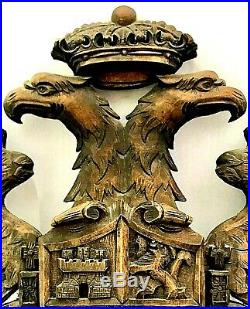
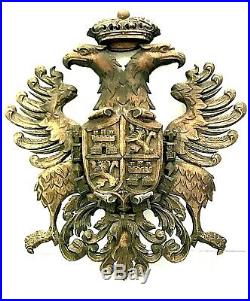
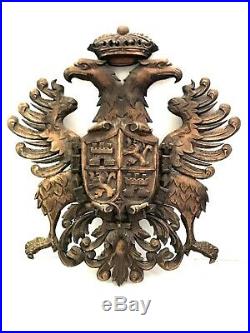
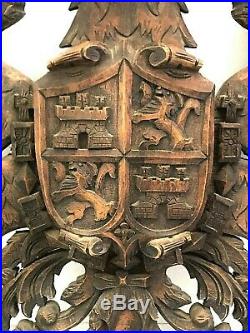
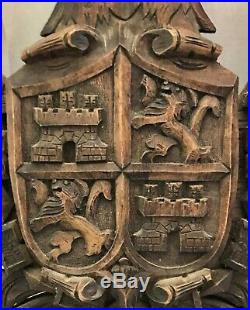
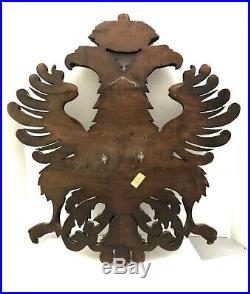
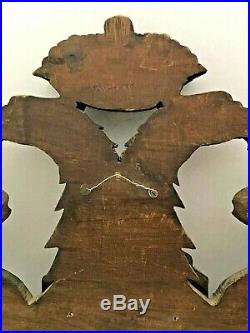
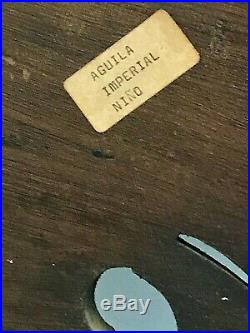
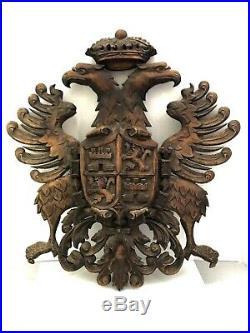
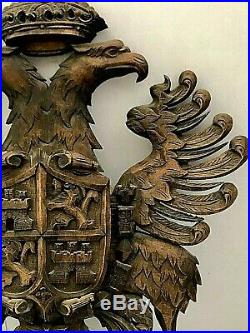
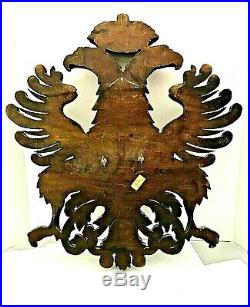

Just look at it. This Antique Wooden Sculpture comes from Spain. And represents the arms of Toledo. It features the crowned double headed eagles with the shield of Castile and Leon at the center (represented by the castles and rampant lions). Surrounding the shield, with a sheep suspended by a ribbon at the bottom. Is the collar of the order of the golden fleece. Hanging Wire on Back. IT WAS WASHED IN A LIGHT GOLD PAINT. Arms of the city of Toledo. Coat of arms of the city of Toledo (Spain). Toledo’s arms are allegedly a grant of Charles V, Holy Roman Emperor. (Charles I as King of Spain). The coat of arms of the city of Toledo consists of the imperial double-headed eagle Sable. (black) bearing an escutcheon with the arms of Castile. In point a pomegranate as in the current Spanish Arms. Surrounded by the collar of the Order of the Golden Fleece. And crowned by the Imperial crown. The eagle is flanked by two figures of kings seated and bearing the attributes of their dignity: sword and scepter. An old privilege granted by the king, Peter of Castile. (Parliament) celebrated in Valladolid. In 1351 1389 of the Spanish era. , stated that the arms of Toledo are those of the monarch. During the reign of Charles I, the city definitely adopted the emperor’s arms, and those are the present arms for the city, adding the figures of the kings, remembering ancient city symbols. The head on the left (West) symbolizes. The head on the right (East) symbolizes. Ecumenical Patriarchate of Constantinople. Use of the double-headed eagle. Is first attested in Byzantine art of the 10th century. Its use as an imperial emblem, however, is considerably younger, attested with certainty only in the 15th century, i. At about the same time the double-headed eagle was also adopted in the Holy Roman Empire. There are speculative theories according to which the double-headed eagle was first introduced as a dynastic emblem of the Komnenoi. From as early as the 11th century. Emperors appear to have used the double-headed eagle often as ornamental emblem on their robes etc. During the 13th and 14th century, but only in the 15th century as an emblem on coins or seals. In the 15th century, the double-heade eagle was first used as an emblem by the semi-autonomous Despots of the Morea. Who were younger imperial princes, and by the Gattilusi. Who were Palaiologan relatives and vassals. The double-headed eagle was used in the breakaway Empire of Trebizond. Of the 14th15th centuries use the double-headed eagle silver/golden on red/ vermilion. As the symbol of Trebizond rather than Constantinople. Single-headed eagles are also attested in Trapezuntine coins, and a 1421 source depicts the Trapezuntine flag as yellow with a red single-headed eagle. Apparently, just as in the metropolitan Byzantine state, the use of both motifs, single and double-headed, continued side by side. Other Balkan states followed the Byzantine model as well: chiefly the Serbians. But also the Bulgarians. Under George Kastrioti better known as Skanderbeg. , while after 1472 the eagle was adopted by Muscovy. When Ivan III of Russia. Daughter of Thomas Palaiologos. In the modern coat of arms of Serbia. 1882 is derived from the coat of arms of the Nemanji dynasty. (16th century), in turn derived from the Byzantine imperial eagle. Use of the double-headed eagle for Serbia is among the examples of early representations in Western portolans. ONE OF A KIND. The item “VINTAGE HAND CARVED COAT OF ARMS WOOD WALL SCULPTURE GOLDEN FLEECE & DBL EAGLES” is in sale since Saturday, August 10, 2019. This item is in the category “Collectibles\Cultures & Ethnicities\European”. The seller is “vontune” and is located in Easton, Connecticut. This item can be shipped to United States, Canada, United Kingdom, Denmark, Romania, Slovakia, Bulgaria, Czech republic, Finland, Hungary, Latvia, Lithuania, Malta, Estonia, Australia, Greece, Portugal, Cyprus, Slovenia, Japan, China, Sweden, South Korea, Indonesia, Taiwan, South africa, Thailand, Belgium, France, Hong Kong, Ireland, Netherlands, Poland, Spain, Italy, Germany, Austria, Bahamas, Israel, Mexico, New Zealand, Philippines, Singapore, Switzerland, Norway, Saudi arabia, Ukraine, United arab emirates, Qatar, Kuwait, Bahrain, Croatia, Malaysia, Chile, Colombia, Costa rica, Panama, Trinidad and tobago, Guatemala, Honduras, Jamaica, Antigua and barbuda, Aruba, Belize, Dominica, Grenada, Saint kitts and nevis, Saint lucia, Montserrat, Turks and caicos islands, Barbados, Bangladesh, Bermuda, Brunei darussalam, Bolivia, Egypt, French guiana, Guernsey, Gibraltar, Guadeloupe, Iceland, Jersey, Jordan, Cambodia, Cayman islands, Liechtenstein, Sri lanka, Luxembourg, Monaco, Macao, Martinique, Maldives, Nicaragua, Oman, Pakistan, Paraguay, Reunion, Uruguay, Russian federation.
- Handmade: Yes
- Country/Region of Manufacture: Spain
- Provenance: ORIGINAL ART CARVED WOOD

Recent Posts
- Chainsaw Carved Welcome Bear Wood Carving Bears Sculpture Statue Rustic Home
- Vintage hand carved wood Folk Art bald eagle bird sculpture statue
- Vintage 1991 Original 15 Forest/Woodland Spirit Wood Carving/ Signed
- Don Rutledge Bear Cub Chainsaw Wood Carving Cabin Sculpture Statue Figure HTF
- Antique hand carved balinese Indonesian Bali lady bust wood carving sculpture
Archives
- July 2025
- June 2025
- May 2025
- April 2025
- March 2025
- February 2025
- January 2025
- December 2024
- November 2024
- October 2024
- September 2024
- August 2024
- July 2024
- June 2024
- May 2024
- April 2024
- March 2024
- February 2024
- January 2024
- December 2023
- November 2023
- October 2023
- September 2023
- August 2023
- July 2023
- June 2023
- May 2023
- April 2023
- March 2023
- February 2023
- January 2023
- December 2022
- November 2022
- October 2022
- September 2022
- August 2022
- July 2022
- June 2022
- May 2022
- April 2022
- March 2022
- February 2022
- January 2022
- December 2021
- November 2021
- October 2021
- September 2021
- August 2021
- July 2021
- June 2021
- May 2021
- April 2021
- March 2021
- February 2021
- January 2021
- December 2020
- November 2020
- October 2020
- September 2020
- August 2020
- July 2020
- June 2020
- May 2020
- April 2020
- March 2020
- February 2020
- January 2020
- December 2019
- November 2019
- October 2019
- September 2019
- August 2019
- July 2019
- June 2019
- May 2019
- April 2019
- March 2019
- February 2019
- January 2019
- December 2018
- November 2018
- October 2018
- September 2018
- August 2018
- July 2018
- June 2018
- May 2018
- April 2018
- March 2018
- February 2018
- January 2018
Categories
- 100×100
- 10pc
- 11-foot
- 110220v
- 110v
- 11ancient
- 11vintage
- 12-piece
- 125x85x6
- 12in
- 13-foot
- 1300x2500mm
- 14th
- 14vintage
- 1500mw
- 15×39
- 1610500mw
- 16th
- 17-inch
- 17th
- 1800s
- 1870's
- 18th
- 18th-19th
- 1900's
- 1920s
- 1930's
- 1940-50's
- 1950's
- 1950s-60s
- 1960s
- 1970s
- 1980s
- 19th
- 2-hand
- 20pc
- 220v
- 227''
- 23-inch
- 23pair
- 24×40
- 2500mw
- 255h
- 26×17
- 28four
- 28×20
- 2pcsteak
- 3-axis
- 3000mw
- 300w
- 3040t
- 30hrs
- 31-24
- 31-24odin
- 31-24wood
- 32in
- 34-inch
- 35-inch
- 35×13
- 35x60cm
- 3axis
- 4-feet
- 4-piece
- 40''
- 4pcs
- 5065cm
- 53151cmworld
- 56-40wood
- 60cm
- 6pcs
- 87cm
- aafa
- abstract
- acanthus
- adam
- addis
- adorable
- adrian
- adrien
- affordable
- african
- agnes
- alabama
- alaska
- alberdi
- alchemy
- alebrije
- alexander
- alfredo
- alice
- alien
- almost
- altar
- alva
- amazing
- american
- ancient
- andy
- angel
- angels
- anglo
- animal
- animals
- anique
- annunciation
- anri
- anri-ferrandiz
- anteater
- antelope
- antique
- antique18c-
- antiquevintage
- antonio
- anubis
- apache
- arabian
- arbortech
- archangel
- archie
- archipelago
- archipenko
- architectural
- arizona
- armadillo
- arnold
- arthur
- artisan
- artist
- artistic
- ashanti
- asherah
- ashley
- asian
- asis
- asmr
- assembled
- assorted
- atlant
- atomstack
- atqe
- attempting
- australian
- authentic
- automatic
- awesome
- axel
- axis
- aztec
- baby
- backgammon
- badger
- baga
- bagus
- bald
- bali
- balinese
- balinese-goddess-legong-dancer-statue-carving-sculpture-carved-wood-bali-art
- ball
- baluster
- bandsawing
- barbara
- barn
- baroque
- bastet
- bath
- bayfield
- beach
- bear
- beautiful
- beautifully
- beaver
- beavercraft
- beginner
- bellamy
- benin
- bergland
- bergner
- best
- betta
- bhumisparsha
- biblical
- bigfoot
- bighorn
- bikers
- bill
- billy
- biomorphic
- bird
- birds
- birth
- bison
- bizarre
- black
- black-capped
- blackamoor
- blas
- blessed
- blessing
- blow
- blue
- boar
- bois
- bone
- bonsai
- boomer'spirit
- bordet
- boruca
- boston
- bottle
- bowl
- boxed
- boxwood
- breathtaking
- brienz
- brown
- bruce
- bruno
- brutalist
- bryan
- bubut
- buck
- buddha
- buffalo
- build
- builds
- bukvall
- bull
- bural
- c17th
- c18th
- caballito
- calm
- cara
- cardinal
- caribou
- carl
- carol
- carousel
- carter
- carve
- carved
- carver
- carvers
- carvers-hand
- carvewright
- carving
- casas
- casket
- castle
- catholic
- cattle
- cedar
- century
- ceremonial
- chaim
- chain
- chainsaw
- chameleon
- charatan
- charles
- charming
- cheerful
- cherries
- cherry
- chester
- chickadee
- chicken
- child
- china
- chinese
- chisel
- chris
- christ
- cigar
- circa
- circle
- clark
- clearance
- client
- clock
- clocks
- cnc3018
- coal
- cocobolo
- collect
- collectible
- collectibles
- collecting
- collection
- color
- colorful
- comical
- commission
- competition
- connie
- contemporary
- copper
- cork
- corpus
- costa
- cougar
- country
- couple
- cowboy
- coyote
- crafting
- crafts
- craftsman
- craig
- creality
- creating
- creative
- cross
- crowned
- crucifix
- crusaders
- cuckoo
- custom
- cutco
- cute
- cutthroat
- cypress
- daibusshi
- dalin
- dangerous
- daniel
- danish
- dante
- dastra
- dave
- david
- davis
- dbxcutter
- deborah
- deco
- decor
- decorative
- decoy
- deer
- delbert
- deluz
- demetz
- demon
- dennis
- dental
- desktop
- detailed
- devil
- dewi
- diego
- different
- digs
- diorama
- disney
- divine
- djembe
- dodo
- dogon
- doll
- dolphin
- dominican
- donna
- door
- double
- dragon
- dragoncarved
- dragonfly
- drake
- drakes
- drapery
- dremel
- drift
- driftwood
- driftwoodart
- druids
- duane
- duck
- durga
- eagle
- early
- earth
- earthy
- easily
- easley
- easy
- ebony
- elder
- electric
- elegant
- elephant
- elephants
- elijah
- elmer
- elmore
- embracing
- emil
- england
- engraving
- entry
- epoxy
- erawan
- eric
- ernesto
- erotic
- escultura
- estate
- eternal
- ethnographic
- european
- evans
- evelyn
- evening
- exceptional
- exotic
- expert
- exquisite
- extra
- extraordinary
- extreme
- extremely
- ezgeberge
- fabulous
- face
- fair
- fairy
- fairyhouse
- fantastic
- farmer
- fastest
- favorite
- feast
- feather
- female
- fierce
- filigree
- filipino
- fine
- first
- fish
- fishing
- flanders
- flexcut
- flight
- floating
- flock
- floral
- flower
- flying
- focusable
- folk
- folkloric
- foot
- foredom
- forged
- formal
- found
- four-poster
- fractal
- fragrance
- frame
- framed
- francis
- frank
- franz
- frederick
- free
- freedman
- french
- full
- gamelan
- ganapati
- gandalf
- ganesh
- ganesha
- garuda
- gator
- gemini
- gene
- génie
- geometric
- george
- georgian
- gert
- giant
- gilded
- gilted
- giovanni
- giraffe
- giuseppe
- glenn
- gluing
- gnome
- goat
- goddes
- godzilla
- goku
- gold
- gold-color
- gorgeous
- gothic
- gouge
- graff
- gransfors
- gray
- grbl
- great
- green
- grey
- griffin
- gryphon
- guanyin
- guardian
- guatemalan
- guide
- gunnar
- haitian
- halali
- halloween
- hammerhead
- hand
- hand-carved
- hand-carved-wood-saint-sculpture
- hand-made
- handcarved
- handcraft
- handcrafted
- handmade
- handstand
- hanging
- hansen
- hanuman
- happy
- hardest
- hares
- havel
- hawaiian
- hawk
- head
- headboard
- headed
- healthy
- hear
- heart
- heavy
- heirloom
- helvie
- henckels
- henri
- henry
- high
- hindu
- hoch
- holy
- holzschnitzerei
- hooded
- hopi
- hornbill
- horse
- hosfeld
- hours
- house
- howard
- howling
- huge
- hulk
- human
- humpback
- hunt
- hunter
- hunting
- hurdy
- hutsuls
- icon
- iconic
- iconostasis
- iguana
- ildefonso
- image
- immaculate
- imposante
- impresionantes
- impressive
- inch
- inches
- incredible
- indian
- indio
- indonesian
- infant
- infinite
- intaglio
- intricately
- intriguing
- intro
- inuit
- iron
- ironwood
- italian
- italy
- jack
- jacques
- jade
- jaguar
- jaipur
- jamaican
- jamie
- japan
- japanese
- jason
- jeanne
- jeff
- jere
- jesus
- jinan
- joaquin
- jockey
- joesue
- johannes
- john
- jorge
- jose
- joseph
- jubilee
- julius
- jumanji
- jumbo
- jungle
- junior
- kachina
- kanok
- kansas
- katlot
- kentucky
- khmer
- kind
- king
- knife
- knight
- knives
- koala
- kobe
- koppy
- krawchuk
- krishna
- krogens
- kruzifix
- kumara
- kunz
- kutzall
- kwakiutl
- kwan
- lacque
- lacquer
- lady
- lama
- laminated
- large
- largest
- larry
- laser
- last
- leaf
- leafy
- learn
- learning
- leather
- lemur
- leonardo
- leroy
- lester
- lewis
- life
- life-like
- life-size
- lifesize
- lilith
- linaloe
- lion
- lion's
- living
- lobster
- logger
- long
- lonnie
- lord
- lords
- lotus
- louis
- louisiana
- lovely
- lucky
- luis
- luxury
- lynx
- machine
- made
- madonna
- maestro
- magia
- magic
- magnificent
- mahatma
- majestic
- make
- makie
- making
- makonde
- male
- malin
- mandala
- mandarin
- manzanita
- maori
- maple
- marco
- mark
- markus
- marley
- marples
- mary
- masara
- masonic
- massim
- massive
- master
- mastercarver
- matt
- mayan
- mcneill
- medallion
- medieval
- medusa
- meiji
- mermaid
- metal
- mexican
- mexico
- michael
- micro
- mid-century
- midcentury
- mieczyslaw
- millers
- mini
- minnie
- mirrored
- miss
- mitsuaki
- möbius
- mod2
- modern
- modernist
- monkey
- months
- monumental
- moon
- mora
- morchella
- most
- mother
- motorcycle
- mule
- mullanium
- multi
- museum
- mystery
- nagu
- nahual
- namaste'
- nancy
- narex
- narwhal
- native
- nativity
- natural
- nature
- nautical
- neil
- neje
- nest
- netsuke
- never
- nice
- nichiren
- nine
- nintendo
- nirvana
- nocturnal
- north
- northstar
- northwest
- nude
- oaxaca
- oaxacan
- oberl
- octopus
- oddities
- odin
- olive
- omtech
- one-of-a-kind
- only
- ooak
- opossum
- orange
- original
- ortur
- otter
- otto
- outsider
- ozark
- pablo
- pacific
- paete
- pair
- paire
- pairvintage
- palau
- palini
- panama
- panel
- pantera
- panti
- paraguayan
- park
- parrot
- patricia
- paul
- peacock
- peacocks
- pear
- pearched
- pedro
- perched
- peregrine
- perfectly
- persian
- pessolano
- peter
- petrified
- pfeil
- pheasant
- philip
- philippines
- phyllis
- physical
- piece
- pieces
- pierced
- pieta
- pillar
- pinocchio
- pintail
- pitz
- plants
- plantsvszombiestimothy
- polar
- polychrome
- poor
- porcupine
- portland
- possum
- power
- powerful
- pre-sale
- premium
- prepare
- primitive
- process
- professional
- pudge
- puerto
- puffer
- puffin
- puppies
- purple
- putti
- puttiangels
- python
- quality
- quintessential
- quixote
- rabbit
- raccoon
- rafael
- raikes
- rainbow
- ralph
- rama
- ramelson
- rare
- rare-1958
- rareantique
- rarevintage
- raven
- raymor
- reading
- real
- realistic
- reclaimed
- rectangle
- red-winged
- redefine
- reducedset
- redwood
- reeder
- reel
- reinaldo
- relaxing
- relief
- religious
- remembering
- renaissance
- repairing
- resin
- restoration
- retro
- reupholstered
- review
- rhino
- rhinoceros
- ribbon
- ribon
- richard
- rick
- rita
- robby
- robert
- rochester
- roger
- rooster
- root
- rose
- rosette
- ross
- rotarex
- rotary
- rotating
- router
- royal
- ruby-throated
- running
- rupicola
- russet
- rustic
- rutledge
- ryobi
- sacred
- saint
- saitama
- sakyamuni
- salazar
- sale-
- samuel
- samurai
- sansone
- saraswati
- satisfying
- schmuckvolle
- scorpion
- screech
- scroll
- sculpted
- sculpting
- sculptor
- sculpture
- seagulls
- seated
- serene
- sergey
- sergio
- seven
- sexy
- shandley
- shane
- shaping
- shark
- shattered
- shell
- shetani
- shinta
- ship
- ships
- shou
- showy
- shun
- sicilian
- signed
- simple
- sirpiworks
- sistine
- site
- sjobergs
- skeleton
- skinny
- skip
- skull
- small
- smoking
- snail
- snake
- snow
- socle
- solid
- sono
- sorrow
- southeast
- southwest
- southwestern
- span
- spectacular
- spectraply
- speed
- spent
- spiral
- spirit
- spoon
- square
- squirrel
- stained
- stan
- stand
- stanley
- start
- stations
- statue
- statues
- statutes
- steampunk
- steel
- steelhead
- stephen
- steps
- steve
- stop
- strange
- strawser
- striking
- stubaiaustria
- stump
- stunning
- stylized
- sunburst
- super
- superb
- superbly
- superbly-carved
- svante
- swamp
- swedish
- swiss
- syroco
- szczepanik
- taber
- table
- take
- taking
- talented
- tall
- taurus
- taylor
- teaching
- teak
- teakbrass
- teakhaus
- tears
- teddy
- tempting
- tempus
- tested
- tête
- texan
- thai
- thaiburmese
- thailand
- thep
- thick
- thin
- thinker
- thomas
- thoughtful
- thrace
- three
- tibet
- tiki's
- time
- timmy
- tinsley
- tiny
- totem
- toucan
- traditional
- trail
- transforming
- transforms
- trapper
- tree
- trés
- tribal
- tried
- triumphant
- tropical
- trygg
- turn
- turned
- turning
- turquoise
- turtle
- twin
- ukrainian
- ultimate
- unbelievable
- Uncategorized
- uncle
- unicorn
- unique
- universe
- unsigned
- unusual
- upgrade
- used
- utrecht
- uttermost
- valencia
- vegeta
- veiled
- vendome
- very
- vevor
- vibrant
- victor
- victorian
- vigilant
- vikings
- vintage
- vintageantique
- vintge
- virgin
- vitarka
- vtge
- vulture
- walking
- wall
- wallace
- walnut
- wara
- warren
- waving
- wayan
- weathered
- welcome
- welliver
- west
- western
- whale
- whales
- wharton
- whimsical
- white
- whitetail
- whittle
- wholesale
- width
- wild
- wildlife
- william
- winged
- winter
- witco
- wizard
- wolf
- woman
- women
- wonderful
- wood
- woodcarving
- woodcarvingtools
- wooden
- woodpecker
- woodriver
- woodturning
- woodworking
- world
- wusthof
- wwii
- xiang
- y1120
- yantra
- year
- yeti
- yoitarikikougyou
- york
- yoruba
- yoshinaotamahagane
- zapotec
- zbor
- zelkova
